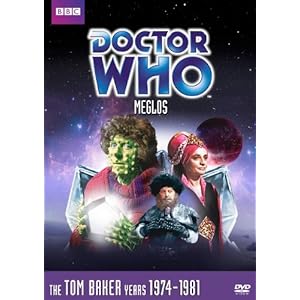| | Doctor Who – Tom Baker 1974-81 |
The man most associated with Doctor Who may also be the most unlikely actor to become such a widely successful celebrity. A bizarre-looking man, Tom Baker's distinctive curly mop of messy brown hair, wide-eyed mad stare and grinning teeth are just as iconic as the multi-colored striped scarf that became a shorthand image of the Doctor still used today. Serving seven long years in the starring role of the BBC's landmark program, Tom Baker has had the most impact on Doctor Who as a program alongside producers John Nathan Turner and Russell T Davies.
In 1974, Doctor Who was at a high point. Former light comedy song and dance man Jon Pertwee had reinvented himself as the dashing dandy with a flair for fast cars and gadgets. Looking to replace Pertwee, producer Barry Letts looked through several possibilities before happening upon Tom Baker, an actor that had made an impression as the larger than life Rasputin in Nicholas and Alexandra. When he had gotten the call from his agent about the job, Baker was working as a laborer. It was too good to be true.
Tom Baker's initial impact was jarring to viewers who had come to regard their hero as a bold and courageous genius. Baker's performance was loose and absurd, making him appear more at home in a Marx Brothers film. His first year on the program, he inherited actress Elisabeth Sladen as Sarah Jane Smith and gained Ian Marter as Harry Sullivan.
Sladen's character, reporter Sarah Jane Smith, had spent her first year learning to trust the Doctor and in the end came to think of him as a protector and hero which made losing him all the more tragic. Ian Marter's Harry Sullivan was a new character who was originally scripted to take on the bulk of the action as the BBC was thinking of casting an older actor to play the Doctor. Against Tom Baker's spry and vibrant Doctor, Harry Sullivan was left with little to do but he remained an important part of the cast.
The fourth Doctor's first year was carefully planned to include famous returning monsters such as the Daleks, Sontarans and the Cybermen who had been absent for many years. After the opening adventure bridging the gap between the old and new in a UNIT-heavy story, the four remaining installments (Ark in Space, Sontaran Experiment, Genesis of the Daleks and Revenge of the Cybermen) comprised a complete tale wrapped around a central setting, the Nerva Beacon. New series producer Philip Hinchcliff and script editor Robert Holmes combined their talents in sculpting out a remarkable opening series that won over fans who perhaps felt dejected over the loss of Pertwee. Rather than a dashing gentleman, the Doctor was more of a wayward prince, both refined and knowledgeable yet scattered and appearing mentally lost. The Doctor still portrayed a brilliance beyond human experience and ingenuity to fix nearly any problem, but his erratic behavior added a new layer of unexpectedness making his actions surprising and sometimes random.
A relatively unknown actor, Tom Baker was suddenly a celebrity. He took the role of being a hero to children very seriously and made a conscious effort to never appear publicly doing anything that would sully the impression of the Doctor. While it is known that he was egocentric and argued with writers, producers, directors and co-stars, many of those same people still regarded him as a major force behind the program and an important component to its success. His archaic speech and witty banter made him one of the more verbose incarnations of the Doctor and his unpredictable demeanor the most alien at times, however he was also terribly human and cherished the simple things such as ginger beer, port and salami. This characterization largely comes from Baker himself who, when faced with the reality pf playing an alien time traveler hundreds of years old he decided to play it as himself as he often struggled to understand his own persona. With any other actor, that idea might have been terrible, and in this case it did lead to many problems when Doctor Who became 'The Tom Baker Show,' but to many viewers, he IS the Doctor.
As Sarah Jane Smith, Lis Sladen had first appeared as an angry young feminist alongside Jon Pertwee. Her character was greatly softened with Baker with whom she felt a genuine rapport. On screen, the two appeared inseparable and the best of friends, making them more sympathetic to the viewer in the face of any monstrous threat. Replacing the companion after Elisabeth Sladen left was a puzzler that the production team met as an opportunity to revisit the role of the 'assistant' or 'screamer.' Thus, the savage Leela was invented as both an interesting character to act opposite the Doctor and 'something for the dads' as she was scantily dressed in leather garments.
Shakespearean actress Louise Jameson was, if anything, over-qualified for the role of Leela. Introduced in Chris Boucher's amazing story, Face of Evil, Leela is an inspired creation that forces the Doctor to react to his companion rather than expect her to blindly follow his lead. Whereas the Doctor was a man of learning and exploration, Leela was a hunter who met any difficulty head-on wielding a ray-gun, knife or Janus thorns as weapons. The pairing went on to become very popular with fans and the addition of the robot dog K-9 only further added to the programs popularity with children.
The loss of Philip Hinchcliff after the critically acclaimed Talons of Weng Chiang led to the appointment of producer Graham Williams. Whereas the previous series had centered on a kind of neo-Gothic cosmic drama, Williams took Doctor Who in a new direction. Wittier writing, added comedy and a lighter touch on danger and drama replaced the dark moodiness and excessive violence that had flourished under Hinchcliff and Holmes. It was an entirely new series in many ways.
The following year saw the departure of Louise Jameson as Leela had left the TARDIS to remain on the Doctor's home planet of Gallifrey. Thinking that he had earned a rest, the Doctor was about to embark on a vacation with a redesigned K-9 when he was recruited into a quest to assemble the Key to Time by the White Guardian. Assigned as his assistant was the precocious young university graduate, every bit refined and regal in contrast to the Doctor's addle-brained professor-look. The series was composed of six separate stories held together by a loosely woven thread of the White Guardian's edict. The third companion for this Doctor, actress Mary Tamm was an ideal choice as her mannerisms and behavior exposed the Doctor's somewhat manic personality and added to the absurd comedy. Script editor Douglas Adams (pre-Hitchhiker's Guide to the Galaxy) contributed greatly to the madcap humor and action of the series.
At the conclusion of the Key to Time, Mary Tamm was replaced by Lalla Ward as the Time Lady Romana spontaneously regenerated into a new body. This was a turn up for viewers who had been taught to look upon regeneration as a drastic action prolong the Doctor's life, but in this case it was a casual decision. In reality, the regeneration was written in to cover the fact that Tamm had left the series, feeling that her character had regressed into the companion that the production team had wanted to get away from, a screaming 'damsel in distress.' As a continuation of Romana's respect for the Doctor and education in his version of the universe, the second Romana was like a female version of the Doctor complete with long scarf and trailing coat. Ward continued to play the part of an educated and somewhat upper-class woman, but with a younger and slightly more spritely air. This blended well with the Doctor who was becoming louder and zanier with each episode.
The fourth Doctor had changed through this five year process from the strange alien to a kind of cartoon character just as Tom Baker's confidence grew as an actor. No longer hiding in floppy coats and high collars, the actor was now dressed mainly in street clothes, a ratty old coat and his trademark multi-colored scarf. The rules of the program were now so loose that nearly anything was possible so long as it amused the production team and lead actor. The series was still very entertaining but it was a far cry from the days of Barry Letts and Terrance Dicks... speaking of whom...
Rumor has it that for a few years Tom Baker had been bored and frustrated with playing the Doctor. Each year he would threaten to leave only to be talked back into coming back. In 1980, his bluff was called by new producer John Nathan Turner. A change was needed and the program that had been the vanguard of British TV science fiction was now looked very dated and stale. A revamped signature tune and logo, new younger companions (Adric, Nyssa and Tegan), a different more science fiction-based tone rather than fanciful comedy and a costume for the lead all meant far too many changes for Baker who was looking more and more like an obstacle to what was becoming a new era. Baker has said that he supported the many changes that script editor Christopher H. Bidmead and producer JNT had envisioned, but he felt that he needed to leave. Baker has acknowledged that he had become a monster to work with and that he had stayed in the role for far too long. Former series producer Barry Letts was brought in to supervise what was a very important changing of the guard.
Tom Baker's final year on Doctor Who was something of a funeral dirge, the central theme of the 18th series being entropy and change. The scheme was to make Baker milder and more subdued to make way for the youthful Peter Davison who was waiting in the wings to take his place as the fifth face of the Doctor. It was a successful and necessary plan as the actor Tom Baker had taken dominance over the concept of Doctor Who. That's not exactly a judgement against Tom Baker, since his personality is in fact larger than life. If anything, the fact that an entire year was dedicated to redefining the program from the Tom Baker Show back to Doctor Who is a testament to how much of an impact his performance had on the series' success.
On his final day of shooting Legopolis, Tom Baker went across to a salon to get his trademark curly locks trimmed. Mimosas were drunk over laughter by all but when he was seen as a new man, no longer the Doctor, he found that no one recognized him. The numerous promises of film and TV performances disappeared (this is paraphrased from Baker's description of the events from the excellent Tom Baker Years VHS set). Dejected, Baker refused to appear in the Doctor Who 20th anniversary special.
Strange as it may seem, it took many years for Tom Baker to be seen as anything other than the man who WAS the Doctor. Since Doctor Who he has gone on to success in several TV productions (such as Blackadder, Little Britain and Randal and Hopkirk Deceased) and is the voice of British Telephone. Since his departure, Baker's performance has influenced every actor to play the Doctor (either as an homage to or in reaction to what had been done before). Many of David Tennant's mannerisms as the tenth Doctor can traced back to Tom Baker's speaking rhythm and body language, for instance. An eccentric of rare wit and vibrant joviality, Doctor Who would not be the program that it is today. He has appeared at many conventions around the world, provided voice-over work to Doctor Who video games and acted as host Doctor Who Night in 1999. With Doctor Who back in its rightful place as a hallmark of British television entertainment, Baker has become an icon of the program's past... and it suits him.
Tom Baker is 77 years old today (the perfect opportunity to finally write my fourth Doctor article!). Seven years of television is a lot of ground to cover and I hope that my readers will pitch in with their thoughts on the Tom Baker era, so please feel free to comment below!
Recommended:
 | WordPress.com | Thanks for flying with WordPress! |
Trouble clicking? Copy and paste this URL into your browser: http://subscribe.wordpress.com




















No comments:
Post a Comment